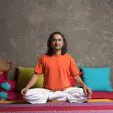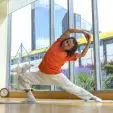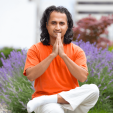Йога с Пракаш

4- или 5-дневен курс по йога с индийския гуру Пракаш
(с включени масажи и планински преходи)
В апартхотел Лъки Банско СПА & Релакс се организират 4- или 5-дневни курсове по йога с индийския гуру Пракаш.
Упражненията по йога се водят лично от Пракаш.
Предвиден е пълен пансион, като храненето е по Аюрведа
В 5-дневните курсове са включени 2 масажа, а в 4-дневните – 1 масаж (50 мин)
Ежедневните планински преходи до най-красивите кътчета на Пирин, Рила и Родопите разтоварват тялото и съзнанието от натрупания стрес и ги презареждат енергийно.
ПРОГРАМА
4- и 5-дневен курс по йога с Пракаш
Първи ден: сряда или четвъртък според избраната от Вас продължителност на курса. Последен ден с отпътуване: неделя.
Важно: 5-дневните пакети започват в сряда, а 4-дневните – в четвъртък (един ден по-късно).
| ПЪРВИ ДЕН (сряда или четвъртък – по Ваш избор) | |
| Настаняване | 14:00 – 15:30 |
| Йога | 16:00 – 17:25 |
| Вечеря | 19:30 – 21:00 |
| Вечерна йога сесия | 21:00 – 21:50 |
| ВТОРИ ДЕН: ЧЕТВЪРТЪК | |
| Топла вода с лимон | 07:20 – 07:30 |
| Сутрешна йога сесия | 07:30 – 09:00 |
| Закуска | 09:00 – 09:30 |
| Подготовка за активности извън хотела | 09:30 – 09:50 |
| Сборен пункт в лоби бара и тръгване за преход | 10:00 – 10:20 |
| Пешеходен преход | 10:20 – 12:30 |
| Връщане от прехода | 12:30 – 12:50 |
| Обяд | 13:00 – 14:00 |
| Време за масаж или СПА & Релакс | 14:00 – 16:00 |
| Следобедна йога сесия | 16:00 – 17:25 |
| Вечеря | 19:30 – 21:00 |
| Вечерна йога сесия | 21:00 – 21:50 |
| ТРЕТИ ДЕН: ПЕТЪК | |
| Топла вода с лимон | 07:20 – 07:30 |
| Сутрешна йога сесия | 07:30 – 09:00 |
| Закуска | 09:00 – 09:30 |
| Подготовка за активности извън хотела | 09:30 – 09:50 |
| Сборен пункт в лоби бара и тръгване за преход | 10:00 – 10:20 |
| Конна езда или пешеходен преход (по избор на участниците) | 10:20 – 12:30 |
| Връщане от прехода | 12:30 – 12:50 |
| Обяд | 13:00 – 14:00 |
| Време за масаж или СПА & Релакс | 14:00 – 16:00 |
| Следобедна йога сесия | 16:00 – 17:25 |
| Вечеря | 19:30 – 21:00 |
| ЧЕТВЪРТИ ДЕН: СЪБОТА | |
| Топла вода с лимон | 07:20 – 07:30 |
| Сутрешна йога сесия | 07:30 – 09:00 |
| Закуска | 09:00 – 09:30 |
| Подготовка за активности извън хотела | 09:30 – 09:50 |
| Сборен пункт в лоби бара и тръгване за преход | 10:00 – 10:20 |
| Пешеходен преход | 10:20 – 12:30 |
| Връщане от прехода | 12:30 – 12:50 |
| Обяд | 13:00 – 14:00 |
| Време за масаж или СПА & релакс | 14:00 – 16:00 |
| Следобедна йога сесия | 16:00 – 17:25 |
| Вечеря | 19:30 – 21:00 |
| Вечерна йога сесия | 21:00 – 21:50 |
| ПЕТИ ДЕН: НЕДЕЛЯ | |
| Топла вода с лимон | 07:20 – 07:30 |
| Йога сесия | 07:30 – 09:30 |
| Закуска | 09:30 – 10:30 |
| Свободно време за СПА & релакс | 10:30 – 12:30 |
| Заминаване | 13:00 |
Курсът Йога с Пракаш включва
- Самостоятелно или двойно настаняване в студио Стандарт;
- Парна баня, сауна, джакузи, контрастни душове, фитнес център TechnoGym (9:00 – 21:00 ч.);
- Ползване на вътрешни плувни био басейни за деца и възрастни с температура на водата 33˚С и солен басейн със соли от Мъртво море (9:00 – 21:00 ч.);
- Солна стая (зона за релакс), облицована с хималайска сол;
- 4 хранения на ден по Аюрведа с ястия, приготвени от индийски готвач. Ежедневно – „жива“ вода сутрин и чаша вино за вечеря;
- 2 релаксиращи масажа с продължителност 50 мин за 5-дневния курс и 1 масаж – за 4-дневния курс. Масажите ще се извършват по график на втория, третия или четвъртия ден. Моля да запишете предпочитан от Вас час на СПА рецепцията;
- Планински преход или езда в конна база Пери Волас (по избор на участниците);
- Безплатен Wi-Fi интернет в целия хотел и две изцяло оборудвани с компютри зони;
- Пакетната цена не включва туристическа такса – 1,50 евро на човек на нощ, която се заплаща на място.
Открийте свободата и радостта от живота с Пракаш – един индийски йога в България!
Условия за резервация:
Резервацията се гарантира с предплащане на 50% oт дължимата сума в срок до 30 дни преди датата на провеждане на курса. Предплатеният депозит не се възстановява в случай на анулиране или промяна на резервацията!
За информация и резервации:


